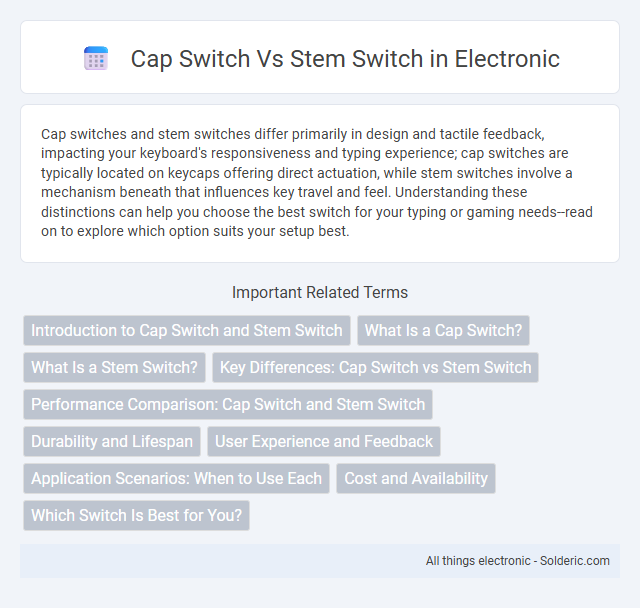Cap switches and stem switches differ primarily in design and tactile feedback, impacting your keyboard's responsiveness and typing experience; cap switches are typically located on keycaps offering direct actuation, while stem switches involve a mechanism beneath that influences key travel and feel. Understanding these distinctions can help you choose the best switch for your typing or gaming needs--read on to explore which option suits your setup best.
Comparison Table
| Feature | Cap Switch | Stem Switch |
|---|---|---|
| Definition | Mechanical switch activated by pressing a keycap directly. | Mechanical switch where the stem is the main moving component under the keycap. |
| Structure | Keycap attaches directly to switch housing. | Keycap fits onto a stem that moves within the switch housing. |
| Durability | Less durable due to simpler mechanism. | Highly durable, designed for heavy typing and gaming. |
| Typing Feel | Often shallow travel distance, less tactile feedback. | Varies by switch type (linear, tactile, clicky) with customizable feedback. |
| Compatibility | Limited keycap compatibility. | Wide compatibility with various keycap sets. |
| Use Case | Basic keyboards, budget models. | Mechanical keyboards, gaming, professional typing. |
Introduction to Cap Switch and Stem Switch
Cap switches and stem switches are essential components in mechanical keyboards that determine key feel and performance. Cap switches sit atop the keycap and directly register key presses, offering distinct tactile feedback suited for various typing preferences. Stem switches refer to the underlying mechanism that moves with each keystroke, affecting durability, actuation force, and responsiveness for optimized keyboard customization.
What Is a Cap Switch?
A cap switch is a mechanical keyboard switch where the keycap directly presses down on the switch mechanism, often featuring a shorter travel distance and distinct tactile feedback. Unlike stem switches, which rely on a separate stem component for actuation, cap switches integrate the pressing surface more closely for faster response times. Your typing experience may feel more precise and efficient with cap switches due to their unique design and operation.
What Is a Stem Switch?
A stem switch refers to the central component of a mechanical keyboard switch responsible for key actuation and tactile feedback. This stem fits into the keycap and moves down when pressed, triggering the switch's internal mechanism to register a keystroke. Understanding how a stem switch works helps you choose the right keyboard switch for preferred typing feel and response.
Key Differences: Cap Switch vs Stem Switch
Cap switches and stem switches differ primarily in their internal mechanisms and tactile feedback. Cap switches use a larger cap that moves over a contact point, providing a distinct tactile response, while stem switches feature a central stem that actuates the switch, often resulting in smoother keystrokes. Your choice depends on the typing experience you prefer, whether it's the tactile click of a cap switch or the refined control of a stem switch.
Performance Comparison: Cap Switch and Stem Switch
Cap switches provide smoother keystrokes with less resistance due to their rubber dome mechanism, offering quieter performance ideal for office environments. Stem switches utilize mechanical metal contacts, delivering faster actuation, tactile feedback, and higher durability, preferred by gamers and typists seeking precision. Your choice between cap switch and stem switch hinges on whether you prioritize quiet, cushioned typing or responsive, high-performance keystrokes.
Durability and Lifespan
Cap switches typically offer enhanced durability due to their robust housing that protects internal components from dust and moisture, extending their lifespan significantly compared to stem switches. Stem switches, while often favored for their tactile feedback and customization options, may be more prone to wear and require more frequent maintenance to maintain optimal performance. Choosing a cap switch can ensure longer-lasting reliability, making it ideal for applications where longevity and minimal downtime are critical for your devices.
User Experience and Feedback
Cap switches typically offer a tactile, responsive feel favored in mechanical keyboards, enhancing typing speed and accuracy for users. Stem switches, like those in Cherry MX designs, provide consistent actuation with less noise, appealing to gamers and professionals seeking quiet performance. User feedback highlights cap switches as satisfying for typing, while stem switches are praised for durability and smooth keystroke action.
Application Scenarios: When to Use Each
Cap switches excel in industrial environments requiring high durability and strict waterproof ratings, such as machinery control panels and outdoor equipment. Stem switches are ideal for consumer electronics and compact devices that prioritize tactile feedback and smaller form factors, like keyboards and handheld gadgets. Choosing between cap and stem switches depends on the need for robustness versus ergonomic design in the product's intended application.
Cost and Availability
Cap switches generally offer lower cost and broader availability due to their simpler design and widespread use in consumer electronics. Stem switches, often used in mechanical keyboards, tend to be pricier and less accessible because of their specialized components and niche market demand. If you are looking to balance budget and ease of replacement, cap switches might better suit your needs.
Which Switch Is Best for You?
Choosing between cap switches and stem switches depends on your typing preferences and keyboard customization goals. Cap switches, often integrated with keycaps, offer a straightforward replacement and a consistent tactile experience, while stem switches provide greater modularity, allowing users to mix and match stems and keycaps for personalized feel and sound. For gamers and typists seeking high responsiveness and tactile feedback, stem switches are typically preferred due to their versatility and enhanced performance options.
cap switch vs stem switch Infographic

 solderic.com
solderic.com